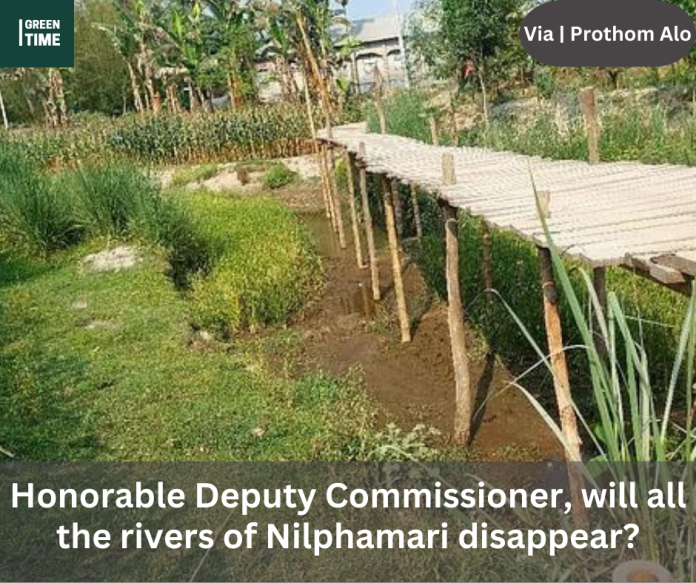In 2011, the Bangladesh Water Development Board published 405 river introduction books. The book does not mention the name of the Bamondanga River in Nilphamari.However, the National River Protection Commission dredged a portion of the river a few years ago. Rivers of Bangladesh, published by the National River Protection Commission in 2023; The river number 632 in the book on definitions and numbers is Bamandanga.
Locals have been asserting that this river bears a person’s name. It’s mysterious how a river, hundreds of years old, can have its entire name named after a person. The District Commissioner has received a letter requesting the registration of the entire river’s land under the river’s and the government’s names.
Another river in Nilphamari is Guptabasini. The river is so narrow that you can jump over it. There is no water in the river. The river is not like a paddy field. The government signboard identifies the Yamuneshwari River as the Deonai River in Domar upazila. Deona is named Yamuneshwari after its confluence with the river Yamuneshwari, much downstream. Earlier, it was written by Deonai.
The Deonai River was originally named after the confluence of two rivers, namely Kherua and Pangha. Kherua entered Bangladesh via the Ketkipara area, which is near the border. The Pangha River enters through the Chilahati area.We are currently cultivating rice on two rivers. There is another big crisis in the Sinhara River in Dimla Upazila of Nilphamari district. The river has diverted its main flow. A portion of the old flow is now in the riverbed’s belly. The Buritista River hosts Dhu Dhu Baluchar.
To protect the rivers, the district administration, Water Development Board, BADC, Barendra Development Authority, LGED, Department of Environment, and other related departments need concerted efforts. The Nilphamari District Commissioner can easily accomplish this task. But will he take the initiative to protect the rivers?
The Nautara River in Dimla Upazila has had water for twelve months, but now it is dry. The Kumlai River finds itself in a similar predicament. Teesta served as the river’s source and confluence. The Water Development Board has closed the source and junction. At a location known as Shutibari, the Water Development Board has established a market, a diagnostic center, a government official’s own house, and a school.
Recently, in Nilphamari, the Riverine People held a press conference to demand 10 points for protecting the Kumlai River. On this river, there are several crossroads without bridges. The Center for Environmental and Geographical Services (CEGIS) is working on the programme titled ‘Updating the information and IT-based management of the rivers of Bangladesh’.

On April 30, 2024, the Divisional Commissioner’s office in Rangpur hosted a workshop on the subject. There, wrong information about many rivers, including the Kumlai River has been provided in the presentation paper. The Dhum River is also not in good condition. The Kharkharia River, which flows through Syedpur Municipality, is dumping a lot of garbage.
Chara, the Charalkata River flows through Nilphamari Sadar Upazila. These two rivers have morphed into seasonal rivers. It is necessary to take special care of the Dhaijan and Mara Dhaijan rivers that flow through Kishoreganj. The condition of the Ichamati River is also alarming.
In Nilphamari district, Teesta is the largest river. Nilphamari district is where the river enters Bangladesh. This river separates Ghaght, a tributary, from the Teesta River. The condition of the Teesta River is terrible. Auliakhan was a tributary of the Teesta River. The Water Development Board has also separated this river from the Teesta. Chungadanga, Burikhora, and Sui rivers are also dying.
So far, 36 rivers have been discovered in Nilphamari. Not a single river in Nilphamari can be considered reasonably good. Every river is in very poor condition. Long-term neglect, carelessness, encroachment, and pollution have rendered the rivers lifeless. The most alarming reality is that there is no government action to protect the rivers.
In 2019, the Riverine People’s initiative, through the struggle of the local people across the river, saved the branch of the Deonai River from illegal encroachment. The efforts of the riverine people have resulted in the demolition of some illegal structures in the Chekadara River. Other than this, there has been no significant work.
To protect the rivers, the district administration, Water Development Board, BADC, Barendra Development Authority, LGED, Department of Environment, and other related departments need concerted efforts. The Nilphamari District Commissioner can easily accomplish this task. But will he take the initiative to protect the rivers?
Despite the declaration of the National River Protection Commission as the river’s guardian, they lack the necessary capacity at the field level. The same goes for the Ministry of Shipping. River organizations must play a leading role in resisting the ongoing attempts to destroy the river. In short, if the government does not fulfill its responsibility for the overall protection of the river, the common people should be organized in thinking about the next generation

